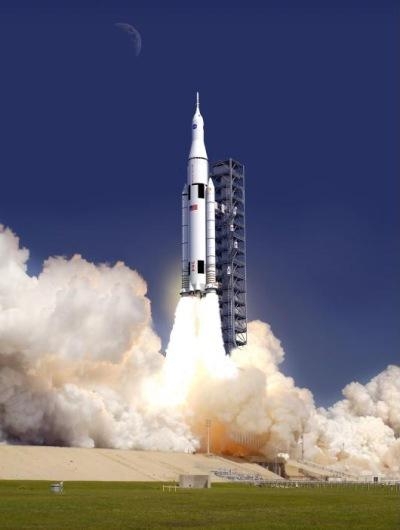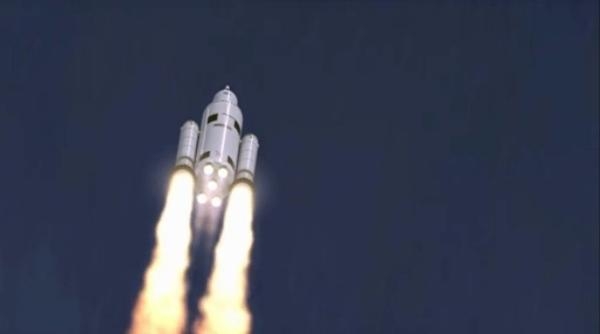Mon, Sep 26, 2011
Sets Timelines For Development Of SLS Components
NASA has released the acquisition overview for the Space Launch
System (SLS), its new, advanced, heavy-lift launch vehicle. NASA
officials say this new heavy-lift rocket - in combination with the
Orion crew capsule already under development, increased support for
the commercialization of astronaut travel to low Earth orbit, an
extension of activities on the International Space Station until at
least 2020, and a fresh focus on new technologies - is key to
implementing the plan laid out by President Obama and Congress in
the bipartisan 2010 NASA Authorization Act.

The booster will be America's most powerful since the Saturn V
rocket that carried Apollo astronauts to the moon and will launch
humans to places no one has gone before. The rocket will give the
nation a safe, affordable and sustainable means of reaching beyond
our current range of space exploration. It will open new
discoveries from unique vantage points and destinations far from
Earth.
The SLS will carry the Orion Multi-Purpose Crew Vehicle and its
astronaut crew, cargo, equipment and science experiments to an
asteroid by the middle of the next decade and then to Mars.
The specific architecture was selected after analysis of the
combination of technologies that would effectively meet the SLS
capability requirements. The architecture also uses an evolvable
development approach. This type of approach allows NASA to address
high-cost development activities early on in the program while
taking advantage of higher buying power before inflation erodes the
available funding in a fixed budget.

Initial planning is for the following:
- Boosters – utilization of the five segment Ares First
Stage Boosters under the existing contract for the initial flights,
the first of which is targeted for the end of 2017.
- Advanced Boosters – to be utilized for missions beyond
the initial flights -The Agency will not specify solutions (i.e.
liquid or solid propulsion may be proposed), but will instead
solicit solutions to meet performance and interface requirements.
-A risk reduction solicitation will be issued later this calendar
year to improve the competitiveness of competing propulsion
technologies and business cases before work begins on the actual
Design, Development, Test and Evaluation (DDT&E) of the final
booster configuration. -DDT&E will be solicited in the
2013-2014 timeframe after results are received from the risk
reduction effort.
- Stages – utilization of the existing Ares Upper Stage
contract for the integrated SLS Core Stage and Upper Stage for the
initial SLS capability through 2021.
- Avionics - utilization of the existing Ares Instrument Unit
Avionics contract for the initial SLS capability through 2021.
- Engines – for the Core and Upper Stages -Core Stage
Engine - utilization of the existing inventory of RS-25Ds for the
initial SLS capability. -Upper Stage Engine – utilization of
the existing Ares J-2X development contract.
- Spacecraft and Payload Adaptors, and Payload Fairing–
initial in-house design efforts followed by competitive
acquisitions beginning in the 2013 timeframe.
- Advanced development - a combination of in-house tasks and
competitive opportunities for industry and academia beginning in
2012.
- Systems Engineering and Integration – NASA led at least
through SLS critical design review (CDR) in 2014.
(Images courtesy NASA)
More News
Runway Lead-in Light System Runway Lead-in Light System Consists of one or more series of flashing lights installed at or near ground level that provides positive visual guidance a>[...]
Aero Linx: Aviation Without Borders Aviation Without Borders uses its aviation expertise, contacts and partnerships to enable support for children and their families – at hom>[...]
Dave Juwel's Aviation Marketing Stories ITBOA BNITBOB ... what does that mean? It's not gibberish, it's a lengthy acronym for "In The Business Of Aviation ... But Not In The Busine>[...]
From 2010 (YouTube Version): Yeah.... This IS A Really Cool Job When ANN's Nathan Cremisino took over the lead of our Aero-TV teams, he knew he was in for some extra work and a lot>[...]
Also: Junkers A50 Heritage, Montaer Grows, Dynon-Advance Flight Systems, Vans' Latest Officially, the Carbon Cub UL and Rotax 916 iS is now in its 'market survey development phase'>[...]
 ANN's Daily Aero-Term (04.24.24): Runway Lead-in Light System
ANN's Daily Aero-Term (04.24.24): Runway Lead-in Light System ANN's Daily Aero-Linx (04.24.24)
ANN's Daily Aero-Linx (04.24.24) Aero-FAQ: Dave Juwel's Aviation Marketing Stories -- ITBOA BNITBOB
Aero-FAQ: Dave Juwel's Aviation Marketing Stories -- ITBOA BNITBOB Classic Aero-TV: Best Seat in The House -- 'Inside' The AeroShell Aerobatic Team
Classic Aero-TV: Best Seat in The House -- 'Inside' The AeroShell Aerobatic Team Airborne Affordable Flyers 04.18.24: CarbonCub UL, Fisher, Affordable Flyer Expo
Airborne Affordable Flyers 04.18.24: CarbonCub UL, Fisher, Affordable Flyer Expo




